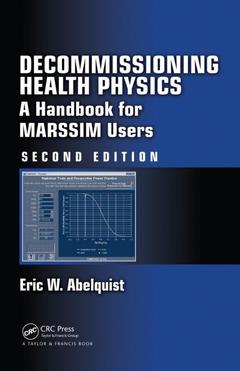Description
Decommissioning Health Physics (2nd Ed.)
A Handbook for MARSSIM Users, Second Edition
Author: Abelquist Eric W.
Language: English
Subjects for Decommissioning Health Physics:
Keywords
Background Reference Areas; Surface Activity Measurements; Gas Proportional Detector; Survey Unit; Soil Contamination; NaI Scintillation Detector; Gm Detector; Gamma Spectroscopy Analyses; DQO Process; Release Criteria; Gamma Spectroscopy; Radionuclide Mixture; Characterization Surveys; Sign Test; Area Factors; Net Count Rate; Background Count Rate; Decay Series; Hot Spot Size; Multiple Radionuclides; Plastic Scintillation Detector; Alpha Spectroscopy; Decommissioning Projects; Inhalation Pathway; Residual Radioactivity
Publication date: 10-2013
Support: Print on demand
Publication date: 12-2019
· 15.6x23.4 cm · Paperback
Description
/li>Contents
/li>Readership
/li>Biography
/li>
Experienced Guidance on the Technical Issues of Decommissioning ProjectsWritten by one of the original MARSSIM authors, Decommissioning Health Physics: A Handbook for MARSSIM Users, Second Edition is the only book to incorporate all of the requisite technical aspects of planning and executing radiological surveys in support of decommissioning. Extensively revised and updated, it covers survey instrumentation, detection sensitivity, statistics, dose modeling, survey procedures, and release criteria.
New to the Second Edition
- Chapter on hot spot assessment that recognizes appropriate dosimetric significance of hot spots when designing surveys and includes a new approach for establishing hot spot limits
- Chapter on the clearance or release of materials, highlighting aspects of the MARSAME manual
- Revised chapter on characterization survey design to reflect guidance in ANSI N13.59 on the value of data quality objectives (DQOs)
- Updated regulations and guidance documents throughout
- Updated survey instrumentation used to support decontamination and decommissioning (D&D) surveys, including expanded coverage of in situ gamma spectrometers
- Revised statistics chapter that includes an introduction to Bayesian statistics and additional double sampling and ranked set sampling statistical approaches
- More case studies and examples throughout
Implement the Surveys Effectively and Avoid Common PitfallsWith more than 20 years of experience as a practitioner in the decommissioning survey field, author Eric W. Abelquist prepares you for the technical challenges associated with planning and executing MARSSIM surveys. He discusses the application of statistics for survey design and data reduction and addresses the selection of survey instrumentation and detection sensitivity. He presents final status survey
Introduction: Current Issues in Decommissioning and MARSSIM Overview. Decommissioning Project Overview and Regulatory Agency Interface. Characterization and the Data Quality Objectives Process (American National Standard N13.59). Guidelines and Dose-Based Release Criteria. Exposure Pathway Modeling—DCGLs and Hazard Assessments. Preliminary Survey Design Concerns and Application of DCGLs. Background Determination and Background Reference Areas. Survey Instrumentation Selection and Calibration. Detection Sensitivity—Static and Scan MDCs. Survey Procedures and Measurement Data Interpretation. Radiological Hot Spot Survey Considerations. Statistics and Hypothesis Testing. MARSSIM Final Status Survey Design and Strategies. MARSSIM Data Reduction. Clearance of Materials—MARSAME Process. Decommissioning Survey Applications at Various Facility Types. Final Status Survey Reports. Practical Applications of Statistics to Support Decommissioning Activities. International Decommissioning Perspectives. References. Solutions to Selected Questions and Problems. Appendices. Index.
Eric W. Abelquist, PhD, CHP, is the executive vice president of Oak Ridge Associated Universities (ORAU) and deputy director of the Oak Ridge Institute for Science and Education (ORISE). He helps oversee organizational best practices, program and business unit leadership, and community relations. He also works directly with the president/CEO to formulate organizational strategic objectives, manage key strategic initiatives, and advise on scientific and engineering issues that advance research and education opportunities. He was previously the associate director for Independent Environmental Assessment and Verification (IEAV) at ORAU, where he contributed to the development and implementation of the Multiagency Radiation Survey and Site Investigation Manual (MARSSIM). He received a Ph.D. in nuclear engineering from the University of Tennessee.




